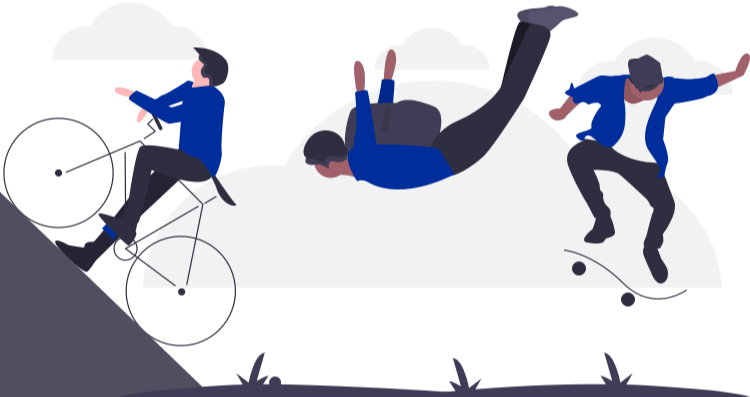While delivering a presentation in front of an audience can be unnerving! Even the most experienced presenters can feel nervous. In this topic, you'll learn what "feeling nervous" is all about, and how you can harness this nervous energy instead of being paralyzed by it.
What does this quote tell you about presenting?
"There are two types of speakers: those that are nervous and those that are liars." – Mark Twain, American writer
Mark Twain emphasizes that it's normal for all speakers to be nervous in front of an audience. So, it's not about whether you feel nervous or not, but how you'll use your nervousness to present more effectively.
What do you think?
When do you think a person is most nervous while preparing and delivering a presentation?
A. The week before
B. Ten minutes before
C. During the first five minutes
D. After the first five minutes
If you guessed option C, During the first five minutes, you're right! Generally, people are most nervous during the first five minutes of a presentation.
Learning about nervousness
The science behind levels of nervousness
The following graph shows the impact of nervousness before and during a presentation. For most people, nervousness peaks as the presentation begins. This is a tough time to be distracted by nervousness because this is when you're making that all-important first impression. But don't worry, it only lasts a few minutes, and then it drops off sharply. You need to be brave for the first five minutes, and after that, you'll find yourself growing calmer and more comfortable.

Symptoms of nervousness
Have you ever experienced the following symptoms?
- Shortness of breath
- Unsteady knees
- Talking too quickly
- Fast heartbeat
- Quivering or weak voice
- Stiff or unnatural body language
All of these symptoms of nervousness can occur while presenting.
What does nervousness feel like?
All of the adventure activities in the following image begin with signs of fear—a rapid heartbeat, for example. But they don't necessarily end unpleasantly.

In fact, within a few minutes of starting the activity your fear may turn into joy. The same is true for the other symptoms of nervousness.
As you present more often, you get used to the symptoms of nervousness and convert them from fear to fun. You might never get over stage fright, but it will stop getting in your way and start energizing you instead.
Techniques to overcome nervousness
To be energized by your nervousness, you first need to be at ease with it. You can do this by applying some simple techniques.
Redefine fear as adrenaline
- Recognize the nervousness you experience when you speak to an audience and redefine it as an adrenaline rush.
- It's possible you might experience symptoms such as dry mouth, shaky knees, or sweaty palms. However, along with these symptoms, you will find that your brain also works faster and you have more energy.
- By recognizing what is happening, you can focus on translating nervousness into momentum and energy.
Focus on the audience, not on yourself
- Focus on your audience while delivering a presentation. By doing this you can stop thinking about your nervousness.
- This allows your mind to engage in constructive thinking instead of being overwhelmed by negative thoughts.
Focus on the emotion that you want to convey
- Evade the fearful mental chatter by focusing on an emotion you want to convey. Identify the emotion with which you want to start your speech.
- It might be anger, joy, or excitement. Relive the emotion by recalling it. Shut your eyes, and put yourself there.
- Focusing on an emotion before the presentation is a powerful way to alleviate nervousness.
Three presentation aspects to manage nervousness
Along with practicing the techniques to overcome nervousness, you should also keep in mind three presentation aspects: head, heart, and body. Focusing on these aspects will help you manage nervousness by getting you into peak form and creating a memorable experience for your audience.
Head
 The head is the intellectual "spine" of your presentation. It represents the ideas that you will present. You should have a clear understanding of these ideas and their order, and this essentially is the structure of your presentation.
Run over the structure in your mind before you present.
The head is the intellectual "spine" of your presentation. It represents the ideas that you will present. You should have a clear understanding of these ideas and their order, and this essentially is the structure of your presentation.
Run over the structure in your mind before you present.
Heart
 The heart represents the emotion you want to exude. Ask yourself the following question: How do I feel about the material I am presenting?
By focusing on this feeling, you'll be able to get into an emotional state that you need to deliver your presentation. It will help your audience identify with the emotion when you begin.
The heart represents the emotion you want to exude. Ask yourself the following question: How do I feel about the material I am presenting?
By focusing on this feeling, you'll be able to get into an emotional state that you need to deliver your presentation. It will help your audience identify with the emotion when you begin.
Body
 The body represents the state of your physical body. If you are nervous, it is a good thing—it means that adrenaline is helping you out. If you are too nervous, then practice some deep belly breathing before you start.
You can do this by taking a deep breath, and feeling your stomach expand as you take air into your lungs. Hold the air, and let it out slowly as you exhale.
The body represents the state of your physical body. If you are nervous, it is a good thing—it means that adrenaline is helping you out. If you are too nervous, then practice some deep belly breathing before you start.
You can do this by taking a deep breath, and feeling your stomach expand as you take air into your lungs. Hold the air, and let it out slowly as you exhale.
More practical tips to override pre-presentation jitters
You've learned several ways to manage your nervousness. Here are some additional tips that you can apply before presenting:
- Have a light workout.
- Get to the room early and get comfortable in it.
- Test your technology in advance.
- Avoid caffeine.
- Engage in positive self-talk.
Key learning points in this topic
It's common to feel nervous before a presentation and while delivering it.
There are various ways to manage nervousness and use the nervous energy to your advantage:
- Redefine fear as adrenaline.
- Focus on the audience, not on yourself.
- Focus on the emotion that you want to convey.
- Consider the three presentation aspects (head, heart, and body) to help get you into peak form and create a memorable experience for your audience.
Once you learn to manage your nervousness, you can effectively showcase the presentation techniques you learned in this course.
